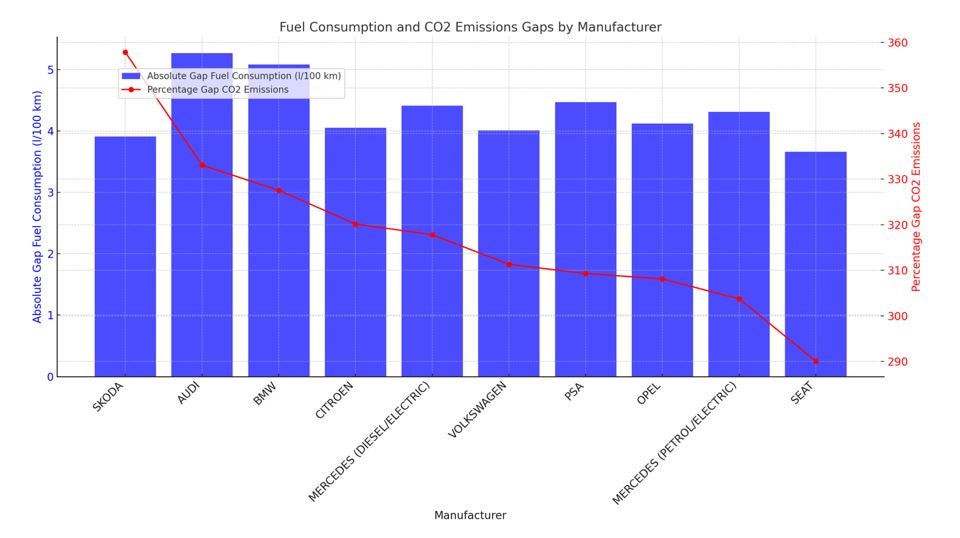
In the ever-evolving landscape of automotive leasing, understanding the real-world performance of vehicles is crucial for making informed decisions. A recent analysis comparing WLTP (Worldwide Harmonized Light Vehicles Test Procedure) values and OBFCM (On-Board Fuel Consumption Monitoring) data for various manufacturers reveals significant gaps in fuel consumption and CO2 emissions.
This discrepancy holds substantial implications for fleet management, cost efficiency, and environmental impact.
The WLTP, overseen by the United Nations Economic Commission for Europe (UNECE), was introduced in September 2017 to standardise vehicle testing procedures globally. It measures fuel consumption and CO2 emissions of new cars and is mandatory for all new vehicles.
The European Commission’s OBFCM regulation, effective January 2021, mandates that all new cars and small vans running on liquid fuels entering the EU market must have approved OBFCM devices. These devices record fuel or energy consumption and total distance driven.

Notes: The data is based on information from the EEA, focusing on vehicle brands and types with more than 100 vehicles to ensure reliability.
Fuel consumption discrepancies
An analysis of data from the European Environmental Agency (EEA), focusing on manufacturers predominantly producing Petrol/Electric vehicles, highlights significant discrepancies between WLTP values and OBFCM data, representing real-world fuel consumption.
Notably, the data for Mercedes includes Diesel/Electric models. The findings show that OBFCM fuel consumption significantly exceeds WLTP values, revealing a substantial absolute and percentage gap across all manufacturers. Only vehicle brands and types with more than 100 vehicles available were included in the analysis to ensure reliability.
For instance, Skoda's Petrol/Electric vehicles show an OBFCM fuel consumption of 5.04 l/100 km compared to a WLTP value of 1.13 l/100 km. This results in an absolute gap of 3.91 l/100 km and a staggering percentage gap of 357.83%. This trend is consistent across other manufacturers, such as Audi with a 333.06% gap and BMW at 327.54%.
CO2 emissions impact
The discrepancies in fuel consumption directly translate to CO2 emissions, a critical factor in assessing environmental impact and compliance with regulatory standards. The weighted percentage gap in CO2 emissions mirrors the pattern observed in fuel consumption discrepancies. Skoda records a weighted CO2 emissions gap of 357.83%, while Audi and BMW follow closely with 333.06% and 327.54%, respectively.
Implications for leasing
- Cost implications: The real-world fuel consumption data suggests that lessees may face higher fuel costs than anticipated based on WLTP values. This disparity can significantly affect total cost of ownership (TCO) calculations and may necessitate adjustments in leasing agreements to account for the increased fuel expenditure.
- Environmental regulations: The significant gap in CO2 emissions data implies potential challenges in meeting environmental regulations. Fleet managers must consider real-world emissions performance to ensure compliance with emissions targets and avoid any penalties.
- Vehicle selection: Leasing companies and fleet managers should leverage this data to make informed decisions on vehicle selection. Understanding the real-world performance of different manufacturers can guide choices towards more fuel-efficient and environmentally friendly options, potentially reducing overall fleet emissions.
- Customer transparency: Providing transparent information to customers about the real-world performance of vehicles is crucial. Educating lessees on the potential discrepancies between WLTP values and actual fuel consumption can help set realistic expectations and improve customer satisfaction.
Next steps: model-level analysis
In analysing this data, we recognise the need to bridge the gap between laboratory and real-world data. We aim to delve deeper into the raw data on a model level to develop correction factors that align more closely with actual performance.
These correction factors will assist leasing companies and fleet managers in adjusting their expectations and strategies, resulting in more accurate forecasting and improved decision-making.
The discrepancies between WLTP and OBFCM data highlight the importance of real-world performance metrics in automotive leasing. Addressing these gaps helps leasing companies manage costs, comply with regulations, and make sustainable vehicle choices. As the industry seeks greater transparency and efficiency, using comprehensive performance data will be crucial.
Petr Thiel is the Founder and CEO of STH Consulting
Related
Corporate car electrification in Europe lags behind private sector: T&E
Zero emissions policies to dominate fleet challenges over next 3 years: Arval







